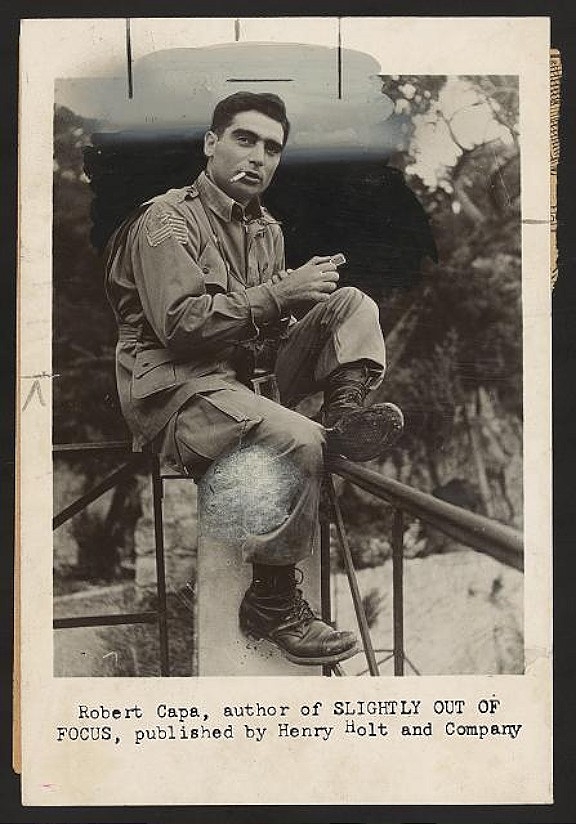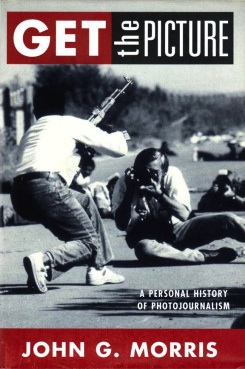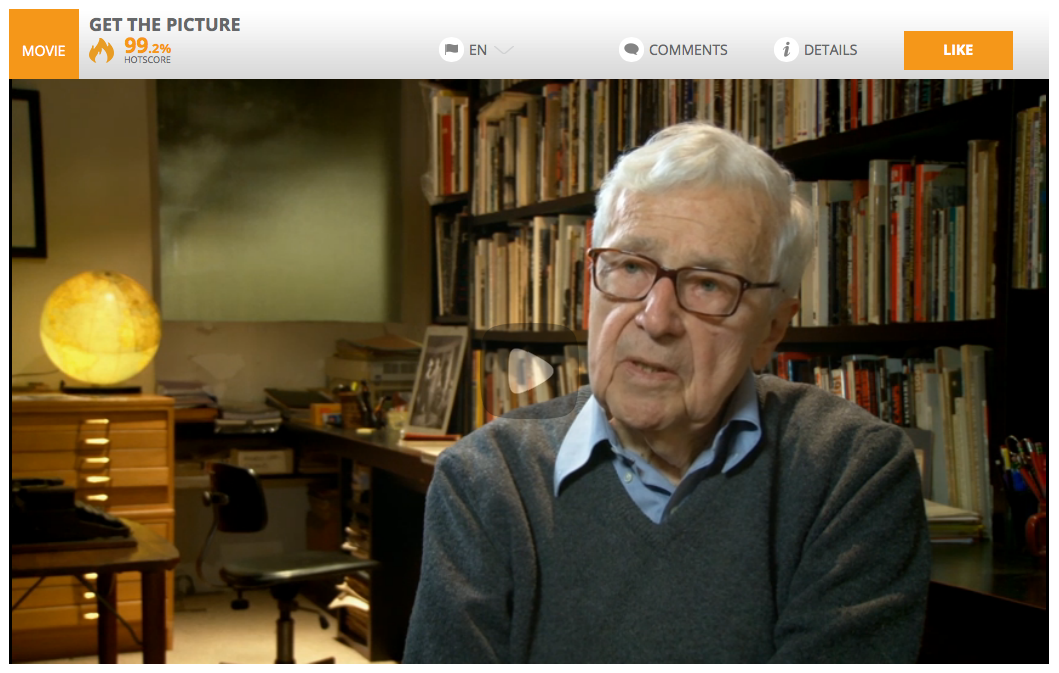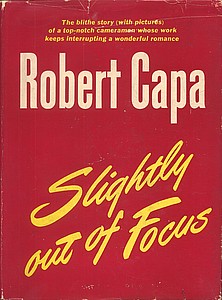 Here is the second part of an email exchange between myself and former LIFE picture editor John G. Morris, who assigned photojournalist Robert Capa to cover the D-Day invasion on Omaha Beach, delegated the development of the films he sent back and the making of prints therefrom, and shipped the results to New York for publication in LIFE and distribution via a wire-service “pool.” (Click here for Part 1 of this Q&A.)
Here is the second part of an email exchange between myself and former LIFE picture editor John G. Morris, who assigned photojournalist Robert Capa to cover the D-Day invasion on Omaha Beach, delegated the development of the films he sent back and the making of prints therefrom, and shipped the results to New York for publication in LIFE and distribution via a wire-service “pool.” (Click here for Part 1 of this Q&A.)
This exchange began when Morris complained about the investigation here at Photocritic International of Capa’s actions and output on Omaha Beach on D-Day, the subsequent fate of his negatives, and related matters. I offered Morris the opportunity to respond, at whatever length he chose; he accepted the offer.
•

Robert Capa, publicity photo for “Slightly Out of Focus,” 1947.
ADC: In Slightly Out of Focus Capa indicates that, upon landing back in England on June 7, knowing that a deadline loomed for both of you, he turned down the offer of a plane ride to London, which would have enabled him to put his films directly in your hands in plenty of time to meet that deadline. Instead, he opted to return to Normandy, turning his films over to a courier, who took an inexplicable 12 hours or more to get them to you — which forced the rush job in the London darkroom that purportedly resulted in the legendary emulsion melt. Thus he really had only himself to blame for that disaster. Correct?
JGM: I know nothing about the offer of a plane ride. I wonder myself why it took so long for the films to reach London. I cannot remember ever asking Dave Scherman, who met Capa in England, for the details. We had all moved on to other things. [LIFE photographer David Scherman met Capa’s boat when it docked at Weymouth on the morning of June 7, and made a portrait of him there. Scherman remembers it docking at Portsmouth, but that contradicts Coast Guard records.]
ADC: You’ve stated that, upon receiving them, with a darkroom staff of 5 on hand and waiting breathlessly and a deadline breathing down your neck, you turned these precious, irreplaceable films over to a 15-year-old “darkroom lad” whose name is variously given as Dennis Sanders (in Whelan’s bio) [Richard Whelan’s authorized Robert Capa: A Biography from 1985] and Dennis Banks (in your accounts). Why did you entrust this delicate task to the least experienced member of your darkroom staff?

John Morris, “Get the Picture” (1998), cover.
JGM: The darkroom was headed by a fiftyish Fleet Street veteran named Bradshaw — “Braddy,” who hired kids at Fleet Street wages to do the work. [Fleet Street in London was the location of offices of British national newspapers and other periodicals, domestic and foreign, until the 1980s.] We were at war! Adults were drafted. I think there were four of them that night including Larry Burrows, whom David Duncan once mistakenly blamed on TV for mishandling Capa’s film that night. We called them all by their first names. I’m sure it was Dennis Banks (Dennis Sanders according to Whelan), who handled those four rolls and rushed to tell me.
So let me tell you about those “pictures lost.” When a packet of Capa’s film arrived early Wednesday evening we were under terrible deadline pressure. The invasion had begun early Tuesday morning and we — LIFE, and the three picture wire services with whom we constituted the pool — still had no good pictures. Bert Brandt of Acme had made a “first picture,” but it didn’t amount to much. I don’t think he had even gotten his feet wet. LIFE‘s Bob Landry had landed on Utah Beach, where there was less fighting, but the pouch with all the Utah film, still and movie, was accidentally dropped into the English channel. And LIFE‘s George Rodger, assigned to land with the British, reported that he had “walked ashore in a blaze of glory” because the German artillery had been knocked out on the beach where he landed.
My deadline for LIFE was a pouch that would close at 9:00 am Thursday in a little office in Grosvenor Square. But the picture pool, headed by E. K. ‘Colonel’ Butler of AP [Associated Press], was screaming for pictures to put on the wire.

John Morris, “Get the Picture” (2013), screenshot
So when the packet from Capa finally arrived I heaved a sigh of relief. It contained films that he had shot on the Channel crossing, both going, with anxious soldiers, and returning, with wounded and dying. For some of these films he had written captions. In addition there were four rolls of 35mm film, with a note: “All the action is in the 35.” I naturally assumed he meant in all four rolls, and ordered the darkroom to give me contact prints as fast as possible, for editing.
[As Simon Kuper puts in his May 31, 2013 interview with Morris for the Financial Times, “Morris has told this tale a thousand times before. Many of his Capa stories have acquired the polish and rhythm of ritual incantations.” Here we have the inevitable recap of the standard narrative Morris presents in Get the Picture. There, and in other accounts before and since, Morris asserts that “A scrawled note (from Capa) said that the action was all in the 35-millimeter, that things had been very rough, that he had come back to England unintentionally with wounded being evacuated, and that he was on his way back to Normandy.” Never reproduced, not even in Morris’s 2004 book D-Day: Robert Capa, which includes much other documentation, this note may be fictitious. Even without such a note, it was reasonable for Morris to assume that Capa would have used his 35mm cameras, rather than the more cumbersome Rolleiflex, for any action photos.]

Robert Capa, “Slightly Out of Focus” (1947), cover.
ADC: In the first published version of the “emulsion melt” story that I can locate, Capa’s own in Slightly Out of Focus (1947), he writes, “[T]he excited darkroom assistant, while drying the negatives, had turned on too much heat and the emulsions had melted and run down before the eyes of the London office.” Obviously he didn’t witness this himself, so he must have heard this from someone who did — you, presumably. Did you actually see pools of melted emulsion running off the film and onto the floor of that makeshift drying cabinet? When you picked up the filmstrips to check them, did any of the warm, still sticky emulsion get on your hands?
JGM: Of course this is all rubbish. Capa embellished the story for Hollywood reasons.
[Earlier in this exchange, Morris writes that Capa hoped to sell the film rights to his memoir. As Simon Kuper puts it in his 2013 Financial Times interview with Morris, clearly quoting or paraphrasing the picture editor, Capa “apparently intended (his book) as a film script. … (He) had played poker or slept with half of Hollywood.”]

Dustjacket blurb, “Slightly Out of Focus” (1947), front cover.
ADC: If the emulsion had actually “melted and run down” those negative strips, it would have left behind clear acetate backing. How do you explain that in light of your persistent description of the “ruined” films as “gray soup,” “pea soup,” etc.?
JGM: Gray soup or pea soup doesn’t matter. There was nothing on those three rolls and I was obviously profoundly shocked.
(To be continued.)
•
(For an index of links to all posts in this series, click here.)
•
This post supported by a donation from Prof. Andrew Szegedy-Maszak, Dept. of Classical Studies, Wesleyan University.
Guest Post 14: Q&A with John Morris (b)
This exchange began when Morris complained about the investigation here at Photocritic International of Capa’s actions and output on Omaha Beach on D-Day, the subsequent fate of his negatives, and related matters. I offered Morris the opportunity to respond, at whatever length he chose; he accepted the offer.
•
Robert Capa, publicity photo for “Slightly Out of Focus,” 1947.
ADC: In Slightly Out of Focus Capa indicates that, upon landing back in England on June 7, knowing that a deadline loomed for both of you, he turned down the offer of a plane ride to London, which would have enabled him to put his films directly in your hands in plenty of time to meet that deadline. Instead, he opted to return to Normandy, turning his films over to a courier, who took an inexplicable 12 hours or more to get them to you — which forced the rush job in the London darkroom that purportedly resulted in the legendary emulsion melt. Thus he really had only himself to blame for that disaster. Correct?
JGM: I know nothing about the offer of a plane ride. I wonder myself why it took so long for the films to reach London. I cannot remember ever asking Dave Scherman, who met Capa in England, for the details. We had all moved on to other things. [LIFE photographer David Scherman met Capa’s boat when it docked at Weymouth on the morning of June 7, and made a portrait of him there. Scherman remembers it docking at Portsmouth, but that contradicts Coast Guard records.]
ADC: You’ve stated that, upon receiving them, with a darkroom staff of 5 on hand and waiting breathlessly and a deadline breathing down your neck, you turned these precious, irreplaceable films over to a 15-year-old “darkroom lad” whose name is variously given as Dennis Sanders (in Whelan’s bio) [Richard Whelan’s authorized Robert Capa: A Biography from 1985] and Dennis Banks (in your accounts). Why did you entrust this delicate task to the least experienced member of your darkroom staff?
John Morris, “Get the Picture” (1998), cover.
JGM: The darkroom was headed by a fiftyish Fleet Street veteran named Bradshaw — “Braddy,” who hired kids at Fleet Street wages to do the work. [Fleet Street in London was the location of offices of British national newspapers and other periodicals, domestic and foreign, until the 1980s.] We were at war! Adults were drafted. I think there were four of them that night including Larry Burrows, whom David Duncan once mistakenly blamed on TV for mishandling Capa’s film that night. We called them all by their first names. I’m sure it was Dennis Banks (Dennis Sanders according to Whelan), who handled those four rolls and rushed to tell me.
So let me tell you about those “pictures lost.” When a packet of Capa’s film arrived early Wednesday evening we were under terrible deadline pressure. The invasion had begun early Tuesday morning and we — LIFE, and the three picture wire services with whom we constituted the pool — still had no good pictures. Bert Brandt of Acme had made a “first picture,” but it didn’t amount to much. I don’t think he had even gotten his feet wet. LIFE‘s Bob Landry had landed on Utah Beach, where there was less fighting, but the pouch with all the Utah film, still and movie, was accidentally dropped into the English channel. And LIFE‘s George Rodger, assigned to land with the British, reported that he had “walked ashore in a blaze of glory” because the German artillery had been knocked out on the beach where he landed.
My deadline for LIFE was a pouch that would close at 9:00 am Thursday in a little office in Grosvenor Square. But the picture pool, headed by E. K. ‘Colonel’ Butler of AP [Associated Press], was screaming for pictures to put on the wire.
John Morris, “Get the Picture” (2013), screenshot
So when the packet from Capa finally arrived I heaved a sigh of relief. It contained films that he had shot on the Channel crossing, both going, with anxious soldiers, and returning, with wounded and dying. For some of these films he had written captions. In addition there were four rolls of 35mm film, with a note: “All the action is in the 35.” I naturally assumed he meant in all four rolls, and ordered the darkroom to give me contact prints as fast as possible, for editing.
[As Simon Kuper puts in his May 31, 2013 interview with Morris for the Financial Times, “Morris has told this tale a thousand times before. Many of his Capa stories have acquired the polish and rhythm of ritual incantations.” Here we have the inevitable recap of the standard narrative Morris presents in Get the Picture. There, and in other accounts before and since, Morris asserts that “A scrawled note (from Capa) said that the action was all in the 35-millimeter, that things had been very rough, that he had come back to England unintentionally with wounded being evacuated, and that he was on his way back to Normandy.” Never reproduced, not even in Morris’s 2004 book D-Day: Robert Capa, which includes much other documentation, this note may be fictitious. Even without such a note, it was reasonable for Morris to assume that Capa would have used his 35mm cameras, rather than the more cumbersome Rolleiflex, for any action photos.]
Robert Capa, “Slightly Out of Focus” (1947), cover.
ADC: In the first published version of the “emulsion melt” story that I can locate, Capa’s own in Slightly Out of Focus (1947), he writes, “[T]he excited darkroom assistant, while drying the negatives, had turned on too much heat and the emulsions had melted and run down before the eyes of the London office.” Obviously he didn’t witness this himself, so he must have heard this from someone who did — you, presumably. Did you actually see pools of melted emulsion running off the film and onto the floor of that makeshift drying cabinet? When you picked up the filmstrips to check them, did any of the warm, still sticky emulsion get on your hands?
JGM: Of course this is all rubbish. Capa embellished the story for Hollywood reasons.
[Earlier in this exchange, Morris writes that Capa hoped to sell the film rights to his memoir. As Simon Kuper puts it in his 2013 Financial Times interview with Morris, clearly quoting or paraphrasing the picture editor, Capa “apparently intended (his book) as a film script. … (He) had played poker or slept with half of Hollywood.”]
Dustjacket blurb, “Slightly Out of Focus” (1947), front cover.
ADC: If the emulsion had actually “melted and run down” those negative strips, it would have left behind clear acetate backing. How do you explain that in light of your persistent description of the “ruined” films as “gray soup,” “pea soup,” etc.?
JGM: Gray soup or pea soup doesn’t matter. There was nothing on those three rolls and I was obviously profoundly shocked.
(To be continued.)
•
(For an index of links to all posts in this series, click here.)
•
This post supported by a donation from Prof. Andrew Szegedy-Maszak, Dept. of Classical Studies, Wesleyan University.